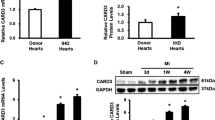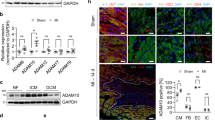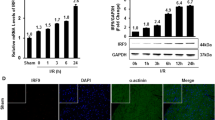Abstract
Cellular FLICE-inhibitory protein (cFLIP) is a member of the tumour necrosis factor signalling pathway and a regulator of apoptosis, and it has a role in cardiac remodelling following myocardial infarction (MI) that remains largely uncharacterised. This study aimed to determine the function of cFLIP as a potential mediator of post-infarction cardiac remodelling. Our results show diminished cFLIP expression in failing human and murine post-infarction hearts. Genetically engineered cFLIP heterozygous (cFLIP+/−, HET) mice, cardiac-specific cFLIP-overexpressing transgenic (TG) mice and their respective wild-type (WT) and non-transgenic controls were subjected to MI by permanent ligation of their left anterior descending artery. Cardiac structure and function were assessed by echocardiography and pressure–volume loop analysis. Apoptosis, inflammation, angiogenesis, and fibrosis were evaluated in the myocardium. The HET mice showed exacerbated left ventricular (LV) contractile dysfunction, dilatation, and remodelling compared with WT mice 28 days after MI. Impaired LV function in the HET mice was associated with increases in infarct size, hypertrophy, apoptosis, inflammation, and interstitial fibrosis, and reduced capillary density. The TG mice displayed the opposite phenotype after MI. Moreover, adenovirus-mediated overexpression of cFLIP decreased LV dilatation and improved LV function and remodelling in both HET and WT mice. Further analysis of signalling events suggests that cFLIP promotes cardioprotection by interrupting JNK1/2 signalling and augmenting Akt signalling. In conclusion, our results indicate that cFLIP protects against the development of post-infarction cardiac remodelling. Thus, cFLIP gene delivery shows promise as a clinically powerful and novel therapeutic strategy for the treatment of heart failure after MI.









Similar content being viewed by others

References
Ayach BB, Yoshimitsu M, Dawood F, Sun M, Arab S, Chen M, Higuchi K, Siatskas C, Lee P, Lim H, Zhang J, Cukerman E, Stanford WL, Medin JA, Liu PP (2006) Stem cell factor receptor induces progenitor and natural killer cell-mediated cardiac survival and repair after myocardial infarction. Proc Natl Acad Sci USA 103:2304–2309. doi:10.1073/pnas.0510997103
Bian Z, Cai J, Shen DF, Chen L, Yan L, Tang Q, Li H (2009) Cellular repressor of E1A-stimulated genes attenuates cardiac hypertrophy and fibrosis. J Cell Mol Med 13:1302–1313. doi:10.1111/j.1582-4934.2008.00633.x
Bueno OF, Molkentin JD (2002) Involvement of extracellular signal-regulated kinases 1/2 in cardiac hypertrophy and cell death. Circ Res 91:776–781
Cao W, Xie YH, Li XQ, Zhang XK, Chen YT, Kang R, Chen X, Miao S, Wang SW (2011) Burn-induced apoptosis of cardiomyocytes is survivin dependent and regulated by PI3K/Akt, p38 MAPK and ERK pathways. Basic Res Cardiol. doi:10.1007/s00395-011-0199-3
Chorianopoulos E, Heger T, Lutz M, Frank D, Bea F, Katus HA, Frey N (2010) FGF-inducible 14-kDa protein (Fn14) is regulated via the RhoA/ROCK kinase pathway in cardiomyocytes and mediates nuclear factor-kappaB activation by TWEAK. Basic Res Cardiol 105:301–313. doi:10.1007/s00395-009-0046-y
Choudhury S, Bae S, Ke Q, Lee JY, Kim J, Kang PM (2011) Mitochondria to nucleus translocation of AIF in mice lacking Hsp70 during ischemia/reperfusion. Basic Res Cardiol 106:397–407. doi:10.1007/s00395-011-0164-1
Conraads VM, Vrints CJ, Rodrigus IE, Hoymans VY, Van Craenenbroeck EM, Bosmans J, Claeys MJ, Van Herck P, Linke A, Schuler G, Adams V (2010) Depressed expression of MuRF1 and MAFbx in areas remote of recent myocardial infarction: a mechanism contributing to myocardial remodeling? Basic Res Cardiol 105:219–226. doi:10.1007/s00395-009-0068-5
Diehl P, Olivier C, Halscheid C, Helbing T, Bode C, Moser M (2010) Clopidogrel affects leukocyte dependent platelet aggregation by P2Y12 expressing leukocytes. Basic Res Cardiol 105:379–387. doi:10.1007/s00395-009-0073-8
Dohrman A, Kataoka T, Cuenin S, Russell JQ, Tschopp J, Budd RC (2005) Cellular FLIP (long form) regulates CD8 + T cell activation through caspase-8-dependent NF-kappa B activation. J Immunol 174:5270–5278. doi:174/9/5270[pii]
Garlanda C, Parravicini C, Sironi M, De Rossi M, Wainstok de Calmanovici R, Carozzi F, Bussolino F, Colotta F, Mantovani A, Vecchi A (1994) Progressive growth in immunodeficient mice and host cell recruitment by mouse endothelial cells transformed by polyoma middle-sized T antigen: implications for the pathogenesis of opportunistic vascular tumors. Proc Natl Acad Sci 91:7291–7295. doi:10.1073/pnas.91.15.7291
Handa P, Tupper J, Jordan K, Harlan J (2011) FLIP (Flice-like inhibitory protein) suppresses cytoplasmic double-stranded-RNA-induced apoptosis and NF-kappaB and IRF3-mediated signaling. Cell Commun Signal 9:16. doi:10.1186/1478-811X-9-16
Haudek SB, Taffet GE, Schneider MD, Mann DL (2007) TNF provokes cardiomyocyte apoptosis and cardiac remodeling through activation of multiple cell death pathways. J Clin Invest 117:2692–2701. doi:10.1172/JCI29134
Heineke J, Molkentin JD (2006) Regulation of cardiac hypertrophy by intracellular signalling pathways. Natl Rev Mol Cell Biol 7:589–600. doi:10.1038/nrm1983
Heusch G, Boengler K, Schulz R (2010) Inhibition of mitochondrial permeability transition pore opening: the Holy Grail of cardioprotection. Basic Res Cardiol 105:151–154. doi:10.1007/s00395-009-0080-9
Hu Y, Zhang H, Lu Y, Bai H, Xu Y, Zhu X, Zhou R, Ben J, Chen Q (2011) Class A scavenger receptor attenuates myocardial infarction-induced cardiomyocyte necrosis through suppressing M1 macrophage subset polarization. Basic Res Cardiol. doi:10.1007/s00395-011-0204-x
Imanishi T, Murry CE, Reinecke H, Hano T, Nishio I, Liles WC, Hofsta L, Kim K, O’Brien KD, Schwartz SM, Han DKM (2000) Cellular FLIP is expressed in cardiomyocytes and down-regulated in TUNEL-positive grafted cardiac tissues. Cardiovasc Res 48:101–110. doi:10.1016/s0008-6363(00)00154-1
Javadov S, Rajapurohitam V, Kilic A, Hunter JC, Zeidan A, Said Faruq N, Escobales N, Karmazyn M (2011) Expression of mitochondrial fusion-fission proteins during post-infarction remodeling: the effect of NHE-1 inhibition. Basic Res Cardiol 106:99–109. doi:10.1007/s00395-010-0122-3
Kleinbongard P, Heusch G, Schulz R (2010) TNFα in atherosclerosis, myocardial ischemia/reperfusion and heart failure. Pharmacol Therapeut 127:295–314. doi:10.1016/j.pharmthera.2010.05.002
Kreuz S, Siegmund D, Rumpf J-J, Samel D, Leverkus M, Janssen O, Häcker G, Dittrich-Breiholz O, Kracht M, Scheurich P, Wajant H (2004) NFκB activation by Fas is mediated through FADD, caspase-8, and RIP and is inhibited by FLIP. J Cell Biol 166:369–380. doi:10.1083/jcb.200401036
Lee P, Sata M, Lefer DJ, Factor SM, Walsh K, Kitsis RN (2003) Fas pathway is a critical mediator of cardiac myocyte death and MI during ischemia-reperfusion in vivo. Am J Physiol Heart Circ Physiol 284:H456–H463. doi:10.1152/ajpheart.00777.2002
Li H-L, Huang Y, Zhang C-N, Liu G, Wei Y-S, Wang A-B, Liu Y-Q, Hui R-T, Wei C, Williams GM, Liu D-P, Liang C-C (2006) Epigallocathechin-3 gallate inhibits cardiac hypertrophy through blocking reactive oxidative species-dependent and independent signal pathways. Free Radic Biol Med 40:1756–1775. doi:10.1016/j.freeradbiomed.2006.01.005
Li H, He C, Feng J, Zhang Y, Tang Q, Bian Z, Bai X, Zhou H, Jiang H, Heximer SP, Qin M, Huang H, Liu PP, Huang C (2010) Regulator of G protein signaling 5 protects against cardiac hypertrophy and fibrosis during biomechanical stress of pressure overload. Proc Natl Acad Sci. doi:10.1073/pnas.1008397107
Li H, Tang QZ, Liu C, Moon M, Chen M, Yan L, Bian ZY, Zhang Y, Wang AB, Nghiem MP, Liu PP (2010) Cellular FLICE-inhibitory protein protects against cardiac remodeling induced by angiotensin II in mice. Hypertension 56:1109–1117. doi:10.1161/HYPERTENSIONAHA.110.157412
Li HL, Wang AB, Huang Y, Liu DP, Wei C, Williams GM, Zhang CN, Liu G, Liu YQ, Hao DL, Hui RT, Lin M, Liang CC (2005) Isorhapontigenin, a new resveratrol analog, attenuates cardiac hypertrophy via blocking signaling transduction pathways. Free Radic Biol Med 38:243–257. doi:10.1016/j.freeradbiomed.2004.10.020
Mersmann J, Habeck K, Latsch K, Zimmermann R, Jacoby C, Fischer JW, Hartmann C, Schrader J, Kirschning CJ, Zacharowski K (2011) Left ventricular dilation in toll-like receptor 2 deficient mice after myocardial ischemia/reper fusion through defective scar formation. Basic Res Cardiol 106:89–98. doi:10.1007/s00395-010-0127-y
Michel MC, Li Y, Heusch G (2001) Mitogen-activated protein kinases in the heart. Naunyn -Schmiedeberg’s Arch Pharmacol 363:245–266. doi:10.1007/s002100000363
Nian M, Lee P, Khaper N, Liu P (2004) Inflammatory cytokines and post myocardial infarction remodeling. Circ Res 94:1543–1553. doi:10.1161/01.RES.0000130526.20854.fa
Shibata R, Izumiya Y, Sato K, Papanicolaou K, Kihara S, Colucci WS, Sam F, Ouchi N, Walsh K (2007) Adiponectin protects against the development of systolic dysfunction following myocardial infarction. J Mol Cell Cardiol 42:1065–1074. doi:10.1016/j.yjmcc.2007.03.808
Skyschally A, van Caster P, Boengler K, Gres P, Musiolik J, Schilawa D, Schulz R, Heusch G (2009) Ischemic postconditioning in pigs: no causal role for RISK activation. Circ Res 104:15–18. doi:10.1161/CIRCRESAHA.108.186429
Steenbergen C, Afshari CA, Petranka JG, Collins J, Martin K, Bennett L, Haugen A, Bushel P, Murphy E (2003) Alterations in apoptotic signaling in human idiopathic cardiomyopathic hearts in failure. Am J Physiol Heart Circ Physiol 284:H268–H276. doi:10.1152/ajpheart.00707.2002
Thome M, Tschopp J (2001) Regulation of lymphocyte proliferation and death by FLIP. Nat Rev Immunol 1:50–58. doi:10.1038/35095508
Walsh K, Shiojima I (2007) Cardiac growth and angiogenesis coordinated by intertissue interactions. J Clin Invest 117:3176–3179. doi:10.1172/JCI34126
Yeh WC, Itie A, Elia AJ, Ng M, Shu HB, Wakeham A, Mirtsos C, Suzuki N, Bonnard M, Goeddel DV, Mak TW (2000) Requirement for Casper (c-FLIP) in regulation of death receptor-induced apoptosis and embryonic development. Immunity 12:633–642. doi:S1074-7613(00)
Yin X-M (2000) Signal transduction mediated by Bid, a pro-death Bcl-2 family protein, connects the death receptor and mitochondria apoptosis pathways. Cell Res 10:161–167. doi:10.1038/sj.cr.7290045
Zhang Y, Zeng Y, Wang M, Tian C, Ma X, Chen H, Fang Q, Jia L, Du J, Li H (2011) Cardiac-specific overexpression of E3 ligase Nrdp1 increases ischemia and reperfusion-induced cardiac injury. Basic Res Cardiol 106:371–383. doi:10.1007/s00395-011-0157-0
Acknowledgments
We thank Dr. Wen-Chen Yeh for providing cFLIP heterozygous mice (cFLIP+/−, HET, CD1 background) and replication-defective adenoviral vectors encoding for the entire coding region of the mouse cFLIP gene. We thank Dr. Annunciata Vecchi for providing H5V mouse heart microvascular endothelial cell line. This study was supported by the National Natural Science Foundation of China (grants 30900524 30972954, 81000036, 81170086, 81000089, and 81000095), and the Support Program for Disciplinary Leaders in Wuhan (200951830561), the National Science and Technology Support Program (2012BAI39B05 and 2011BAI15B02), the Hubei Funds for Distinguished Young Scientists (2010CDA092) and the National Basic Research Program of China (2011CB503902).
Conflict of interest
The authors declare that they have no conflict of interest.
Author information
Authors and Affiliations
Corresponding author
Additional information
J. Xiao, M. Moon and L. Yan contribute equally to this work.
Electronic supplementary material
Below is the link to the electronic supplementary material.
Rights and permissions
About this article
Cite this article
Xiao, J., Moon, M., Yan, L. et al. Cellular FLICE-inhibitory protein protects against cardiac remodelling after myocardial infarction. Basic Res Cardiol 107, 239 (2012). https://doi.org/10.1007/s00395-011-0239-z
Received:
Revised:
Accepted:
Published:
DOI: https://doi.org/10.1007/s00395-011-0239-z



